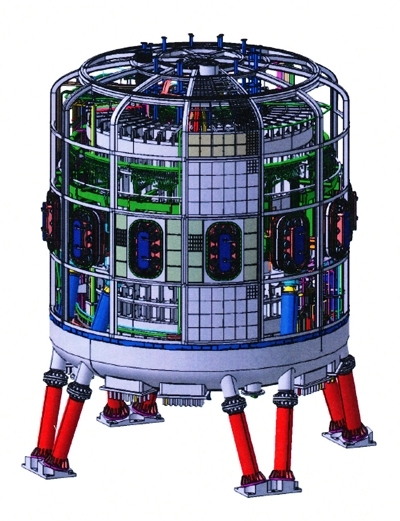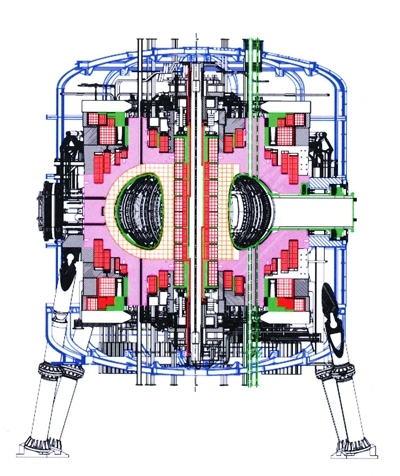Russia and Italy have entered into an agreement to build a new fusion reactor outside Moscow that could become the first such reactor to achieve ignition, the point where a fusion reaction becomes self-sustaining instead of requiring a constant input of energy. The design for the reactor, called Ignitor, originated with MIT physics professor Bruno Coppi, who will be the project’s principal investigator.
The concept for the new reactor builds on decades of experience with MIT’s Alcator fusion research program, also initiated by Coppi, which in its present version (called Alcator C-Mod) has the highest magnetic field and highest plasma pressure (two of the most important measures of performance in magnetic fusion) of any fusion reactor, and is the largest university-based fusion reactor in the world.
The key ingredient in all fusion experiments is plasma, a kind of hot gas made up of charged particles such as atomic nuclei and electrons. In fusion reactors, atomic nuclei — usually of isotopes of hydrogen called deuterium and tritium — are forced together through a combination of heat and pressure to overcome their natural electrostatic repulsion. When the nuclei join together, or fuse, they release prodigious amounts of energy.
Ignitor would be about twice the size of Alcator C-Mod, with a main donut-shaped chamber 1.3 meters across, and have an even stronger magnetic field. It will be much smaller and less expensive than the major international fusion project called ITER (with a chamber 6.2 meters across), currently under construction in France. Though originally designed to achieve ignition, the ITER reactor has been scaled back and is now not expected to reach that milestone.
The Ignitor reactor, Coppi says, will be “a very compact, inexpensive type of machine,” and unlike the larger ITER could be ready to begin operations within a few years. Its design is based on a particularly effective combination of factors that researchers unexpectedly discovered during the many years of running the Alcator program, and that were later confirmed in experiments at other reactors. Together, these factors produce especially good confinement of the plasma and a high degree of purity (impurities in the hot gases can be a major source of inefficiency). The new design aims to preserve these features to produce the highest plasma current densities — the amount of electric current in a given area of plasma. The design also has additional structures needed to produce and confine burning fusion plasmas in order to create the conditions needed for ignition, Coppi says.
A project at Lawrence Livermore National Laboratory in California, called the National Ignition Facility, uses a completely different approach to fusion, bombarding a tiny pellet of fuel with laser beams to create the heat and pressure needed for fusion. But some physicists disagree on the exact meaning of fusion ignition, and whether the results of the planned experiments at NIF can truly be considered ignition. ”I don’t understand how they define ignition,” Coppi says of what is being planned at NIF.
Coppi plans to work with the Italian ministry of research and Evgeny Velikhov, president of the Kurchatov Institute in Moscow, to finalize the distribution of tasks for the machine, the core of which is to be built in Italy and then installed in Troitsk, near Moscow, on the site of that institute’s present Triniti reactor. Velikhov, as it happens, is also the chair of the ITER council. Coppi says of these two different programs, “there’s no competition, we are complementary.”
Although seen as a possible significant contributor to the world’s energy needs because it would be free of greenhouse-gas emissions, practical fusion power remains at least two decades away, most scientists in the field agree. But the initial impetus for setting up the Alcator reactor in the 1970s had more to do with pure science: “It was set up to simulate the X-ray stars that we knew at that time,” says Coppi, whose research work has as much to do with astrophysics as with energy. Stars are themselves made of plasma and powered by fusion, and the only way to study their atomic-level behavior in detail is through experiments inside fusion reactors.
Once the reactor was in operation, he says, “we found we were producing plasmas with unusual properties,” and realized this might represent a path to the long-sought goal of fusion ignition.
Roscoe White, a distinguished research fellow at the Princeton Plasma Physics Laboratory, says that “the whole point of Ignitor is to find out how a burning plasma behaves, and there could be pleasant or unpleasant results coming from it. Whatever is learned is a gain. Nobody knows exactly how it will perform, that is the point of the experiment.” But while its exact results are unknown, White says it is important to pursue this project in addition to other approaches to fusion. “With our present knowledge it is very risky to commit the program to a single track reactor development — our knowledge is still in flux,” he says.
In addition, he says, “the completion of ITER, the only currently projected burning plasma experiment, is decades off. Experimental data concerning a burning plasma would be very welcome, and could lead to important results helping the cause of practical fusion power.” Furthermore, the Ignitor approach, if all goes well, could lead to more compact and economical future reactors: Some recent results from existing reactors, plus new information to be gained from Ignitor, “could lead to reactor designs much smaller and simpler than ITER,” he says.
Coppi remains especially interested in the potential of the new reactor to make new discoveries about fundamental physics. Quoting the late MIT physicist and Institute Professor Bruno Rossi, Coppi says, “whenever you do experiments in an unknown regime, you will find something new.” The new machine’s findings, he suggests, “will have a strong impact on astrophysics.”
The concept for the new reactor builds on decades of experience with MIT’s Alcator fusion research program, also initiated by Coppi, which in its present version (called Alcator C-Mod) has the highest magnetic field and highest plasma pressure (two of the most important measures of performance in magnetic fusion) of any fusion reactor, and is the largest university-based fusion reactor in the world.
The key ingredient in all fusion experiments is plasma, a kind of hot gas made up of charged particles such as atomic nuclei and electrons. In fusion reactors, atomic nuclei — usually of isotopes of hydrogen called deuterium and tritium — are forced together through a combination of heat and pressure to overcome their natural electrostatic repulsion. When the nuclei join together, or fuse, they release prodigious amounts of energy.
Ignitor would be about twice the size of Alcator C-Mod, with a main donut-shaped chamber 1.3 meters across, and have an even stronger magnetic field. It will be much smaller and less expensive than the major international fusion project called ITER (with a chamber 6.2 meters across), currently under construction in France. Though originally designed to achieve ignition, the ITER reactor has been scaled back and is now not expected to reach that milestone.
The Ignitor reactor, Coppi says, will be “a very compact, inexpensive type of machine,” and unlike the larger ITER could be ready to begin operations within a few years. Its design is based on a particularly effective combination of factors that researchers unexpectedly discovered during the many years of running the Alcator program, and that were later confirmed in experiments at other reactors. Together, these factors produce especially good confinement of the plasma and a high degree of purity (impurities in the hot gases can be a major source of inefficiency). The new design aims to preserve these features to produce the highest plasma current densities — the amount of electric current in a given area of plasma. The design also has additional structures needed to produce and confine burning fusion plasmas in order to create the conditions needed for ignition, Coppi says.
A project at Lawrence Livermore National Laboratory in California, called the National Ignition Facility, uses a completely different approach to fusion, bombarding a tiny pellet of fuel with laser beams to create the heat and pressure needed for fusion. But some physicists disagree on the exact meaning of fusion ignition, and whether the results of the planned experiments at NIF can truly be considered ignition. ”I don’t understand how they define ignition,” Coppi says of what is being planned at NIF.
Coppi plans to work with the Italian ministry of research and Evgeny Velikhov, president of the Kurchatov Institute in Moscow, to finalize the distribution of tasks for the machine, the core of which is to be built in Italy and then installed in Troitsk, near Moscow, on the site of that institute’s present Triniti reactor. Velikhov, as it happens, is also the chair of the ITER council. Coppi says of these two different programs, “there’s no competition, we are complementary.”
Although seen as a possible significant contributor to the world’s energy needs because it would be free of greenhouse-gas emissions, practical fusion power remains at least two decades away, most scientists in the field agree. But the initial impetus for setting up the Alcator reactor in the 1970s had more to do with pure science: “It was set up to simulate the X-ray stars that we knew at that time,” says Coppi, whose research work has as much to do with astrophysics as with energy. Stars are themselves made of plasma and powered by fusion, and the only way to study their atomic-level behavior in detail is through experiments inside fusion reactors.
Once the reactor was in operation, he says, “we found we were producing plasmas with unusual properties,” and realized this might represent a path to the long-sought goal of fusion ignition.
Roscoe White, a distinguished research fellow at the Princeton Plasma Physics Laboratory, says that “the whole point of Ignitor is to find out how a burning plasma behaves, and there could be pleasant or unpleasant results coming from it. Whatever is learned is a gain. Nobody knows exactly how it will perform, that is the point of the experiment.” But while its exact results are unknown, White says it is important to pursue this project in addition to other approaches to fusion. “With our present knowledge it is very risky to commit the program to a single track reactor development — our knowledge is still in flux,” he says.
In addition, he says, “the completion of ITER, the only currently projected burning plasma experiment, is decades off. Experimental data concerning a burning plasma would be very welcome, and could lead to important results helping the cause of practical fusion power.” Furthermore, the Ignitor approach, if all goes well, could lead to more compact and economical future reactors: Some recent results from existing reactors, plus new information to be gained from Ignitor, “could lead to reactor designs much smaller and simpler than ITER,” he says.
Coppi remains especially interested in the potential of the new reactor to make new discoveries about fundamental physics. Quoting the late MIT physicist and Institute Professor Bruno Rossi, Coppi says, “whenever you do experiments in an unknown regime, you will find something new.” The new machine’s findings, he suggests, “will have a strong impact on astrophysics.”







